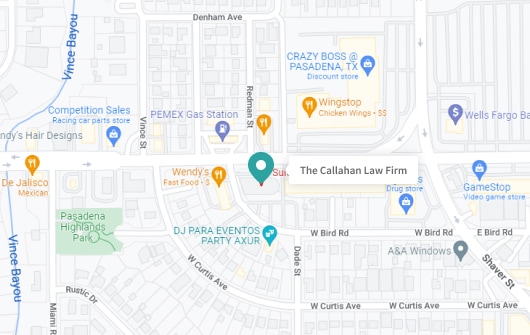Is Jaywalking Legal in Texas?

Understanding the laws related to jaywalking in Texas is crucial for both pedestrians and drivers. Jaywalking, or crossing the street outside of designated crosswalks, can lead to legal and safety issues.
For pedestrians, it’s important to know that not following these laws can result in fines and increase the risk of accidents. Drivers, on the other hand, must be vigilant and aware of pedestrians who may be crossing illegally.
If you’ve been involved in a jaywalking incident or have questions about pedestrian laws, don’t hesitate to reach out to The Callahan Law Firm. Contact us today to ensure your rights are protected and to receive the guidance you need.
The Legalities of Jaywalking in Texas
In Texas, jaywalking refers to pedestrians crossing the street outside of designated crosswalks or failing to yield to traffic when required. While Texas does not have a specific state law for jaywalking, local municipalities often have ordinances that regulate pedestrian behavior and impose penalties for violations.
In many cities, such as Austin and Dallas, jaywalking can result in fines ranging from $100 to $500. These fines are typically issued when pedestrians cross streets illegally or fail to use marked crosswalks at intersections. The severity of the penalty can depend on factors such as the location of the crossing and whether the pedestrian’s actions contributed to a traffic incident.
For example, a pedestrian who crosses a busy intersection without a crosswalk or ignores traffic signals may be more likely to receive a citation. In more severe cases, if the jaywalking results in an accident or near-miss, additional legal consequences or increased fines may apply.
Understanding these local regulations is essential for avoiding fines and ensuring safety on the roads. Always check your city’s specific ordinances to stay informed about the rules in your area.
Jaywalking Laws in Texas
In Texas, jaywalking laws were formalized through local ordinances rather than state legislation as cities developed rules to address growing traffic volumes and enhance pedestrian safety. These regulations focus on maintaining order at busy intersections.
Nationally, Texas’s approach aligns with broader trends where pedestrian safety is managed locally, guided by the Uniform Vehicle Code, which influences many traffic laws. Despite this alignment, enforcement and specifics can vary widely across different jurisdictions.
Comparison with Other States
- California: In cities like Los Angeles and San Francisco, jaywalking laws are stricter, with higher fines and more active enforcement. The California Vehicle Code explicitly addresses jaywalking and provides detailed regulations.
- New York: Jaywalking is also regulated at the local level, with fines and penalties varying by borough. New York City has aggressive enforcement policies to manage high pedestrian traffic.
- International Perspective: In countries like Japan and Germany, jaywalking is rarely an issue due to well-developed pedestrian infrastructure and strict enforcement. These countries often have fewer pedestrian accidents due to extensive traffic planning.
Penalties for Jaywalking in Texas
In Texas, the penalties for jaywalking are primarily monetary and vary by locality. The penalties include:
- Fines: The maximum fines for jaywalking typically range from $20 to $50. These fines are imposed for violations such as crossing streets outside of designated crosswalks or ignoring traffic signals. The amount can differ depending on the city’s specific ordinances.
- Imprisonment: While imprisonment is rare, some jurisdictions may impose short jail sentences for repeated or egregious violations, particularly if the jaywalking incident resulted in a serious traffic incident or injury. However, this is not common practice and is usually reserved for severe cases.
- Legal Consequences for Non-Compliance: Jaywalkers who resist fines or exhibit reckless behavior, such as aggressive interactions with law enforcement or endangering others while crossing streets illegally, may face additional legal issues. These could include increased fines, possible arrests, or even charges related to disorderly conduct.
Understanding and complying with local pedestrian laws can help avoid these penalties and ensure personal safety on the roads.
Drivers’ Liability in Jaywalking Accidents
When drivers are involved in accidents with jaywalkers, they have specific legal responsibilities and must take precautionary measures to avoid such incidents:
1. Legal Responsibilities
Drivers must be cautious, especially in areas where pedestrians may be present. This includes adhering to speed limits, being vigilant at crosswalks, and being prepared to stop for pedestrians who may unexpectedly enter the roadway. Even if a pedestrian is jaywalking, drivers can still be held liable if they were not attentive or driving recklessly.
2. Determining Fault
The determination of fault in jaywalking accidents can be complex. Factors such as driver speed, attention, and pedestrian behavior must be carefully considered. Shared fault may occur if both parties were negligent. In some cases, if a pedestrian is crossing unlawfully but a driver was speeding or distracted, fault may be shared. Courts will examine evidence such as traffic camera footage, witness testimonies, and accident reports to ascertain liability.
3. Legal Repercussions for Hit-and-Run
Fleeing the scene of an accident, including those involving jaywalkers, can lead to severe legal consequences. Hit-and-run incidents are taken very seriously and can result in criminal charges, including fines and imprisonment. It is crucial for drivers to stop, provide assistance if needed, and report the incident to authorities to avoid these serious repercussions.
Drivers must be aware of their responsibilities and the potential legal consequences of their actions to ensure safety and compliance with the law.
Legal Ramifications of Unpaid Jaywalking Fines

Failing to pay jaywalking fines in Texas can lead to several serious consequences:
- Increased Penalties: Unpaid fines may accumulate additional fees and interest, significantly increasing the total amount owed. This can make resolving the issue more difficult and costly over time.
- Legal Actions: Continued failure to pay can result in legal actions such as collection efforts or court judgments. These actions may involve wage garnishment or property liens to recover the owed amount.
- Jail Time: While imprisonment for unpaid jaywalking fines is rare, some jurisdictions may impose jail time for persistent non-payment, particularly if the fines are associated with other legal issues or repeated violations.
Guidance for Addressing Unpaid Fines
If you are unable to pay a fine, it’s important to contact the court where the citation was issued. Many courts offer payment plans or allow you to contest the fine through a formal hearing.
Seeking legal advice can also be beneficial. Consulting with an attorney can provide guidance on how to handle unpaid fines and navigate any potential legal actions or consequences.
Addressing unpaid jaywalking fines promptly can help prevent the escalation of legal issues and ensure compliance with local regulations.
Staying Informed and Safe: Your Next Steps
Understanding jaywalking laws in Texas is crucial for both pedestrian safety and drivers. Local ordinances regulate pedestrian behavior, with fines and penalties varying by city. Jaywalking, while often seen as a minor infraction, can lead to serious consequences if not addressed properly. It’s important to follow pedestrian safety regulations to avoid accidents and legal issues.
If you find yourself involved in a jaywalking-related incident or need guidance on navigating pedestrian laws, The Callahan Law Firm is here to help. Our seasoned team can provide expert advice and support to ensure your rights are protected and your legal matters are handled effectively. Contact our car accident lawyers today to schedule a no-fee consultation, and let us see how we can assist you.
FAQ
What happens if you hit a Jaywalker in Texas?
If you hit a jaywalker in Texas, the determination of fault depends on the specific circumstances. Even if the pedestrian was jaywalking, drivers may still be held partially or fully liable, particularly if they were speeding, distracted, or failed to exercise caution.
How much is a jaywalking ticket in Texas?
In Texas, jaywalking fines typically range from $20 to $50, depending on the specific city ordinances. The fine may increase if the violation leads to a traffic incident or if there are repeated offenses.
Is jaywalking illegal in the USA?
Yes, jaywalking is generally illegal across the USA, though laws and penalties vary by state and local jurisdiction. Most areas require pedestrians to cross at designated crosswalks or intersections to avoid fines and ensure safety.

Michael S Callahan is an attorney and founder of The Callahan Law Firm. He focuses his practice on representing individuals and families in personal injury cases involving motor vehicle and truck accidents, workplace accidents and defective products. With over 25 years of experience, he is dedicated to fighting on behalf of people whose lives have been forever altered by the negligence and carelessness of corporations and individuals. Originally trained as a mechanical engineer, Michael has been practicing law and fighting for justice for those who need it most since 1994. He is board-certified in Personal Injury Trial Law by the Texas Board of Legal Specialization and a member of various esteemed legal associations. Outside of work, Michael enjoys spending quality time with his family, outdoor activities, and continually striving to improve as a trial lawyer and human being.











